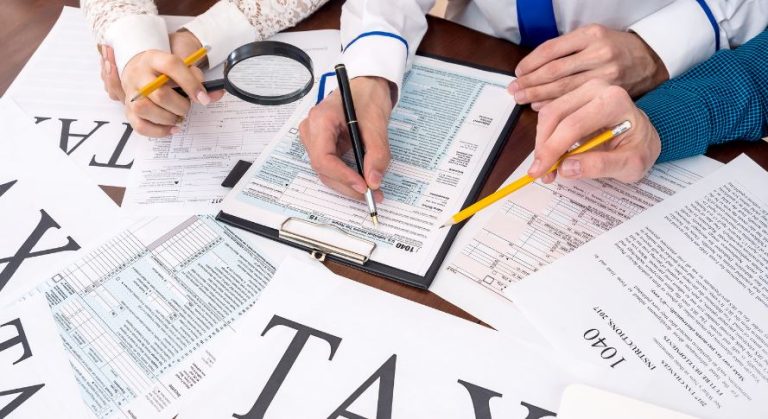Are you wondering how to pay advance tax online? With the growing digitisation of tax systems, taxpayers can now easily fulfil their advance tax obligations through online platforms.
Whether you are a salaried individual, self-employed professional, or business owner, understanding the process of advance tax payment is crucial to avoiding penalties and ensuring compliance with tax regulations.
This guide will walk you through everything you need to know about paying advance tax online. It covers the eligibility criteria, calculation methods, online payment options, HMRC guidelines, and possible consequences of non-payment.
What Is Advance Tax?

Advance tax, often referred to as “pay-as-you-earn” tax, is a system where taxpayers make periodic payments towards their annual tax liability.
Instead of paying the entire tax amount at the end of the financial year, taxpayers are required to pay it in instalments throughout the year based on their estimated income.
Who Needs to Pay Advance Tax?
Advance tax is applicable to individuals and businesses whose tax liability exceeds a certain threshold. In the UK, it generally applies to:
- Self-employed individuals with significant taxable income.
- Business owners who do not have tax automatically deducted through PAYE.
- Freelancers and contractors earning above a specific limit.
- Salaried employees with additional income from investments, rental properties, or freelancing.
- Companies that generate profits and are subject to corporate tax.
Exemptions from Advance Tax Payment
Certain individuals and organisations may be exempt from paying advance tax:
- Salaried employees whose tax is deducted at source through PAYE.
- Individuals whose total taxable income falls below the taxable limit.
- Senior citizens without business income.
- Non-profit organisations with tax exemptions.
Understanding whether you are liable to pay advance tax helps in planning your finances efficiently and avoiding penalties.
Why Is Advance Tax Payment Important?
Advance tax payment plays a vital role in ensuring the smooth functioning of a country’s tax system. It provides benefits to both taxpayers and the government.
Importance of Advance Tax Payment
- Prevents Last-Minute Tax Burden: Paying tax in installments reduces the financial strain of paying a large lump sum at the end of the financial year.
- Avoids Penalties and Interest: Non-payment or underpayment of advance tax can lead to penalties and interest charges.
- Ensures a Steady Revenue Flow for the Government: The government collects revenue throughout the year, allowing better financial planning.
- Helps in Better Financial Management: Taxpayers can allocate funds efficiently rather than facing unexpected tax liabilities at year-end.
- Encourages Tax Compliance: Regular tax payments ensure that individuals and businesses remain compliant with tax laws.
Ignoring advance tax payments can result in additional financial burdens, making timely payment essential for financial stability.
How Is Advance Tax Calculated?

The calculation of advance tax is based on estimated annual income and applicable tax rates. Proper estimation ensures that taxpayers do not overpay or underpay their taxes.
Steps to Calculate Advance Tax
- Estimate Total Income: Calculate your expected income from all sources, including salary, business profits, rental income, and investments.
- Deduct Allowable Expenses and Exemptions: Identify eligible deductions under tax laws, such as business expenses, mortgage interest, or investment exemptions.
- Determine Taxable Income: Subtract deductions from the total estimated income to arrive at the taxable amount.
- Apply the Applicable Tax Rate: Use the prevailing tax slabs to calculate the tax liability on your taxable income.
- Subtract Any Tax Credits or TDS: Reduce the calculated tax liability by deducting any tax already deducted at source (TDS) or applicable tax credits.
- Divide the Tax Liability into Instalments: Based on government-mandated installments, divide the final tax liability into multiple payments.
Accurate advance tax calculation ensures compliance and prevents financial surprises at the end of the financial year.
What Are the Due Dates for Advance Tax Payment in the UK?
In the UK, advance tax payment due dates for self-employed individuals and businesses follow specific deadlines.
Self-Assessment Tax Deadlines
- 31 January: First advance tax payment (for the tax year ending the previous April).
- 31 July: Second advance tax payment.
- 31 January (Next Year): Final settlement of any outstanding balance.
Corporate Tax Advance Payment
Corporations making profits above a certain threshold may have to pay tax in instalments based on their financial performance. Large companies typically follow a quarterly instalment payment system.
Staying aware of tax deadlines helps taxpayers avoid penalties and interest charges.
How to Pay Advance Tax Online?

Paying advance tax online is simple and can be done through government portals or authorised banking channels.
Step-by-Step Guide to Pay Advance Tax Online
- Visit the HMRC Website: Navigate to the official HMRC tax payment portal.
- Log in to Your Account: Use your unique taxpayer reference (UTR) and password to log in.
- Choose the Payment Option: Select “Make a Payment” and opt for advance tax payment.
- Enter the Tax Amount: Based on your calculation, input the correct tax amount.
- Select a Payment Method: Choose from available options like online banking, debit/credit card, or direct bank transfer.
- Confirm and Complete the Payment: Verify the details and submit your payment.
After successful payment, it is recommended to save the transaction receipt for future reference.
Which Online Payment Methods Can Be Used for Advance Tax?
In the UK, taxpayers can pay advance tax online through several secure and convenient payment methods. The most commonly used options include:
- Online Banking (Faster Payments, CHAPS, BACS): Allows direct bank transfers from your account to HMRC. Faster Payments are usually instant, while BACS may take up to three working days.
- Debit or Credit Card Payments: Taxpayers can pay via the HMRC portal using a debit or credit card. Credit card payments may include additional charges.
- Direct Debit: You can set up a Direct Debit with HMRC, which automatically deducts the amount from your account on the due date.
- HMRC’s Payment Gateway: The government’s official online payment portal allows users to make payments securely.
- Standing Orders for Businesses: Large businesses paying corporate tax may use standing orders for regular instalment payments.
Choosing the right payment method ensures that the advance tax payment is processed smoothly and within the deadline.
What Are the Steps to Pay Advance Tax via the HMRC Portal?

Paying advance tax through the HMRC online portal is a straightforward process. Follow these steps:
- Visit the HMRC Official Website: Go to the HMRC payment portal.
- Log in Using Government Gateway Credentials: Enter your Unique Taxpayer Reference (UTR) and password.
- Navigate to the Payment Section: Select the option for “Make a Payment.”
- Choose the Tax Type: Select “Self-Assessment Tax” for individuals or “Corporation Tax” for businesses.
- Enter the Payment Amount: Calculate and input the correct tax amount based on your advance tax liability.
- Select a Payment Method: Choose from available options like bank transfer, debit/credit card, or Direct Debit.
- Confirm and Complete the Payment: Double-check the details and submit the payment.
- Save the Payment Confirmation: Keep a digital copy or printout of the receipt for future reference.
Payments through the HMRC portal are processed quickly, ensuring timely compliance with tax regulations.
Can Advance Tax Be Paid Through Online Banking?
Yes, advance tax can be paid through online banking. HMRC allows taxpayers to make payments using the following online banking methods:
- Faster Payments: Transfers are usually instant and can be done 24/7 through online banking apps.
- BACS (Bankers’ Automated Clearing Services): Transfers take around three working days to process.
- CHAPS (Clearing House Automated Payment System): Same-day transfers are available if completed within the bank’s working hours.
To pay advance tax using online banking, follow these steps:
- Log in to Your Online Banking Portal: Access your bank’s online or mobile banking service.
- Select ‘Make a Payment’: Choose the option to transfer funds.
- Enter HMRC’s Bank Details: Use the correct sort code and account number provided by HMRC.
- Enter Your Unique Taxpayer Reference (UTR): This ensures HMRC correctly allocates your payment.
- Confirm and Submit the Payment: Verify the details and complete the transfer.
Using online banking for tax payments is secure and allows for easy tracking of transactions.
What Happens If Advance Tax Is Not Paid on Time?

Failure to pay advance tax on time can result in financial penalties and additional interest charges. The consequences include:
- Interest on Late Payments: HMRC charges interest on overdue tax payments from the due date until full payment is made.
- Late Payment Penalty: If the tax remains unpaid after a certain period, additional penalties may apply.
- Increased Financial Burden: Delayed payments accumulate interest, increasing the overall tax liability.
- Legal Action in Severe Cases: In extreme cases of non-payment or tax evasion, HMRC may take legal action.
To avoid these issues, taxpayers should ensure timely payment by setting reminders or using automatic payment methods such as Direct Debit.
How to Claim a Refund for Overpaid Advance Tax?
If you have overpaid advance tax, you can request a refund from HMRC. The process is as follows:
- Check Your Tax Calculation: Verify that you have indeed overpaid by reviewing your tax records.
- Log in to HMRC’s Online Portal: Use your Government Gateway credentials to access your account.
- Request a Refund: Select the refund option and provide the necessary details.
- Enter Your Bank Details: Ensure the correct bank account details are provided for the refund.
- Submit the Request: Confirm and submit your refund claim.
- Wait for HMRC Processing: Refunds are usually processed within a few weeks and transferred directly to your bank account.
If the refund is not credited within the expected time, taxpayers can contact HMRC’s support team for further assistance.
Conclusion
Understanding how to pay advance tax online ensures that taxpayers remain compliant with tax laws while avoiding penalties. With multiple online payment options available, making advance tax payments has never been easier.
By estimating income correctly, meeting deadlines, and using digital payment platforms, taxpayers can efficiently manage their tax obligations.
FAQs
What is the penalty for late advance tax payment?
Late payments attract interest charges and possible penalties imposed by tax authorities.
Can I modify my advance tax payment after submission?
If you overpay, you can adjust the final payment or apply for a refund.
Is advance tax applicable to pensioners?
Pensioners without business income are generally exempt from advance tax payments.
What if I estimate my income incorrectly?
Adjustments can be made in subsequent instalments, and refunds are available for excess payments.




